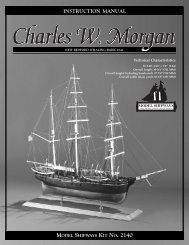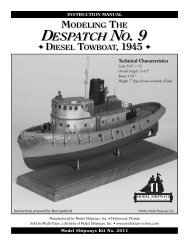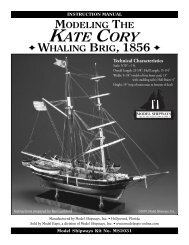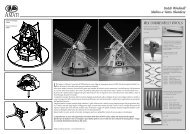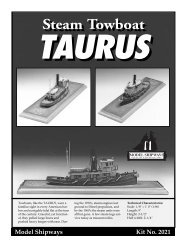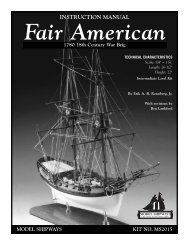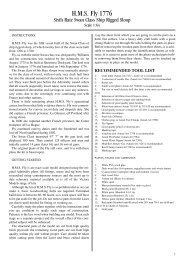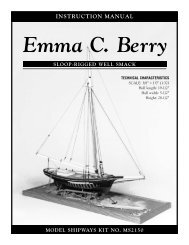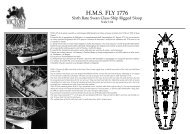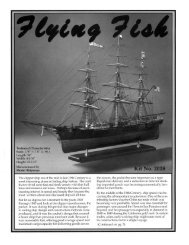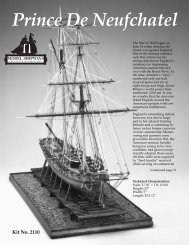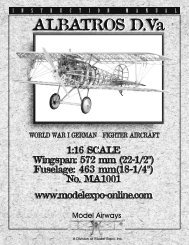download benjamin latham instruction manual
download benjamin latham instruction manual
download benjamin latham instruction manual
Create successful ePaper yourself
Turn your PDF publications into a flip-book with our unique Google optimized e-Paper software.
Now make and fit these members to the mast, securing them<br />
firmly with glue and pins. Allow them to dry firmly.<br />
Meanwhile, fashion the spreaders from 1/16” x 3/32” stripwood,<br />
tapered as directed on Sheet 4 of the plans. Make end<br />
notchings and add any prescribed eyebolts, but do not glue the<br />
spreaders to the trestletrees until the masts are ready to rig. If<br />
installed now, they will surely break.<br />
Bands for the halyards: These may be added now. It was common<br />
practice with Essex-built craft to drive the halyard ringbolts<br />
through the masts and the bands, then secure them with<br />
fore locks (see figure 43). One simple method to simulate this is<br />
to glue a strip of rag paper around the mast, drill a hole<br />
through it and the mast, and drive in a ringbolt, bending it over<br />
at the far side. When painted, the paper band can look very<br />
convincingly like metal. Metal bands can be made as shown in<br />
figure 1a.<br />
Throat halyard cranes: These should be fitted next. But, DO<br />
NOT GLUE the throat halyard cranes in place until after the<br />
spreaders are installed at rigging time. If you wish, make the<br />
heart irons and linkages for the throat halyard blocks, paint<br />
them, hook them to the cranes, and set these assemblies aside<br />
until they are needed (see figure 44).<br />
FIG. 40 – Tapering Masts & Spars<br />
Plane<br />
Spar<br />
Plane in this direction<br />
(Always with the grain)<br />
Make more<br />
strokes at this end<br />
(tapered end)<br />
Plane in this direction<br />
TAPERING A DOWEL<br />
When the taper has been “4-sided”, as shown above, it may then<br />
be “8-sided”, “16-sided”, then rounded with a file, and sanded<br />
smooth. (Dotted lines indicate wood to be removed)<br />
4-sided<br />
8-sided<br />
16-sided<br />
Rounded<br />
FIG. 41 – Lower Mast Head<br />
7/32”<br />
FIG. 42 – Mast & Spar Curvature<br />
Halyard tension<br />
Dashed lines indicate<br />
rake of masts and steeve<br />
of bowsprit prior to<br />
setting up the stays.<br />
Sagging in<br />
boom crotch<br />
Topping lift<br />
Taper is blended to<br />
smooth contours<br />
above spreaders<br />
A<br />
“Flatted”<br />
for cheeks port<br />
& starboard<br />
Level of<br />
trestle trees<br />
Taper is<br />
quite<br />
pronounced<br />
Taper is<br />
slight<br />
A’<br />
This shows with some exageration (but not much!) the degrees<br />
and directions of warpage of spars induced by rigging, sagging,<br />
and tension from running rigging and sails.<br />
FIG. 43 – Mast Head Bands & Eyes<br />
Actual Practice:<br />
ring bolt goes through<br />
band; sets up on forward<br />
side of mast head<br />
Fore-locks<br />
Ring bolt<br />
Section A-A’<br />
9/32”<br />
5/16”<br />
Diameter at deck<br />
Ring<br />
For Models:<br />
wire eyebolt goes through<br />
paper or shim band, is bent<br />
over on forward side<br />
Mast band<br />
Bent over<br />
Eyebolt<br />
Ring<br />
25



